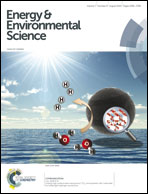Insitu nanotomography and operando transmission X-ray microscopy of micron-sized Ge particles†
Abstract
To design an inexpensive, non-toxic, practical replacement to the internal combustion engine, significant advances in battery technology are required. Germanium anodes offer more than four times larger capacity than presently used graphite anodes. Yet large volume changes during operation severely limit their lifetime. To understand the origin, dynamics, and failure mechanisms of these and other electrode materials, it is essential to image batteries under operating conditions. Using transmission X-ray microscopy the morphology and electron density changes in Ge anode particles are tracked during operation. We observe significant size dependence on the cycling characteristics of Ge particles. Only Ge particles with diameters larger than a few microns display cracks during cycling. Small Ge particles experience volume expansion and cracking before their larger counterparts, but rapidly lose electrical contact. With in situ nanotomography, we demonstrate unambiguously for the first time the fracturing of alloying anode materials into completely unconnected pieces. Moreover, we show that the density changes due to lithiation are consistent with partial transformation into a Li15Ge4-like phase. Our results demonstrate the significant value in linking electrochemical performance studies with morphological evolution to understand failure mechanisms and encourage more systematic searches for a viable high capacity anode material.


 Please wait while we load your content...
Please wait while we load your content...